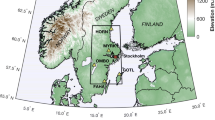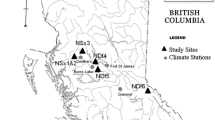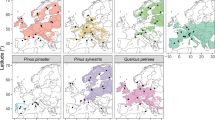Abstract
Traditionally, high-latitude dendroclimatic studies have focused on measurements of total ring width (RW), with the maximum density of the latewood (MXD) serving as a complementary variable. Whilst MXD has typically improved the strength of the growing season climate connection over that of RW, its measurements are costly and time-consuming. Recently, a less costly and more time-efficient technique to extract density measurements has emerged, based on lignin’s propensity to absorb blue light. This Blue Intensity (BI) methodology is based on image analyses of finely-sanded core samples, and the relative ease with which density measurements can be extracted allows for significant increases in spatio-temporal sample depth. While some studies have attempted to combine RW and MXD as predictors for summer temperature reconstructions, here we evaluate a systematic comparison of the climate signal for RW and latewood BI (LWBI) separately, using a recently updated and expanded tree ring database for Labrador, Canada. We demonstrate that while RW responds primarily to climatic drivers earlier in the growing season (January–April), LWBI is more responsive to climate conditions during late spring and summer (May–August). Furthermore, RW appears to be driven primarily by large-scale atmospheric dynamics associated with the Pacific North American pattern, whilst LWBI is more closely associated with local climate conditions, themselves linked to the behaviour of the Atlantic Multidecadal Oscillation. Lastly, we demonstrate that anomalously wide or narrow growth rings consistently respond to the same climate drivers as average growth years, whereas the sensitivity of LWBI to extreme climate conditions appears to be enhanced.










Similar content being viewed by others
References
Banfield CE, Jacobs JD (1998) Regional patterns of temperature and precipitation for Newfoundland and Labrador during the past century. Can Geogr 42:354–364
Barrand NE, Way RG, Bell T, Sharp MJ (2017) Recent changes in area and thickness of Torngat Mountain glaciers (northern Labrador, Canada). The Cryosphere 11:157–168
Björklund JA, Gunnarson BE, Seftigen K, Esper J, Linderholm HW (2013) Is Blue Intensity ready to replace maximum latewood density as a strong temperature proxy? A tree-ring case study on Scots pine from northern Sweden. Clim Past Discuss 9:5227–5261
Björklund JA, Gunnarson BE, Seftigen K, Esper J, Linderholm HW (2014) Blue intensity and density from northern Fennoscandian tree rings, exploring the potential to improve summer temperature reconstructions with earlywood information. Clim Past 10:877–885
Björklund J, Gunnarson BE, Seftigen K, Zhang P, Linderholm HW (2015) Using adjusted Blue Intensity data to attain high-quality summer temperature information: a case study from Central Scandinavia. The Holocene 25:547–556
Briffa KR, Melvin TM (2011) A closer look at regional curve standardization of tree- ring records: justification of the need, a warning of some pitfalls, and suggested improvements in its application. In: Hughes MK, Swetnam TW, Diaz HF (eds) Dendroclimatology. Springer, Dordrecht, pp 113–145
Brown R, Lemay M, Allard M, Barrand NE, Barrette C, Bégin Y, Dibike Y (2012) Climate variability and change in the Canadian Eastern Subarctic IRIS region (Nunavik and Nunatsiavut). Nunavik and Nunatsiavut: From science to policy. An Integrated Regional Impact Study (IRIS) of climate change and modernization, pp 57–93
Campbell R, McCarroll D, Loader N, Grudd H, Robertson I, Jalkanen R (2007) Blue intensity in Pinus sylvestris tree rings: developing a new palaeoclimate proxy. The Holocene 17:821–828
Catto JL, Jakob C, Berry G, Nicholls N (2012) Relating global precipitation to atmospheric fronts. Geophys Res Lett 39(L10):805. https://doi.org/10.1029/2012GL051736
Chang EK, Lee S, Swanson KL (2002) Storm track dynamics. J Clim 15(16):2163–2183
Compo GP, Whitaker JS, Sardeshmukh PD, Matsui N, Allan RJ, Yin X, Brönnimann S (2011) The twentieth century reanalysis project. Q J R Meteorol Soc 137(654):1–28
Cook ER (1985) A time series analysis approach to tree-ring standardization. Ph.D. Dissertation, University of Arizona, Tucson, p 171
Cook ER, Kairiukstis L (1990) Methods of dendrochronology. Springer, New York
D’Arrigo R, Jacoby GC, Free RM (1992) Tree-ring width and maximum latewood density at the North American tree line: parameters of climatic change. Can J For Res 22(9):1290–1296
D’Arrigo R, Buckley B, Kaplan S (2003) Interannual to multidecadal modes of Labrador climate variability inferred from tree rings. Clim Dyn 20:219–228
D’Arrigo R, Wilson R, Liepert B, Cherubini P (2008) On the ‘divergence problem’ in northern forests: a review of the tree-ring evidence and possible causes. Glob Planet Change 60(3–4):289–305
Durbin J, Watson GS (1951) Testing for serial correlation in least squares regression. II. Biometrika 38(1/2):159–177
Farebrother RW (1980) The Durbin-Watson test for serial correlation when there is no intercept in the regression. Econometrica 48:1553–1563
Finnis J, Bell T (2015) An analysis of recent observed climate trends and variability in Labrador. Can Geographer/Le Géogr Can 59(2):151–166
Fritts HC (2012) Tree rings and climate. Elsevier, Amsterdam
Fukazawa K (1992) Ultraviolet microscopy. In: Lin SY, Dence CW (eds) Methods in lignin chemistry. Springer, Berlin, pp 110–121
Goldhar C, Bell T, Wolf J (2014) Vulnerability to freshwater changes in the Inuit settlement region of Nunatsiavut, Labrador: a case study from Rigolet. Arctic 67:71–83
Harris I, Jones PD, Osborn TJ, Lister DH (2014) Updated high-resolution grids of monthly climatic observations - the CRU TS3.10 Dataset. Int J Climatol 34:623–642
Holmes RL (1983) Computer-assisted quality control in tree-ring dating and measurement. Tree Ring Bull 43:69–77
Huang B, Banzon VF, Freeman E, Lawrimore J, Liu W, Peterson TC, Smith TM, Thorne PW, Woodruff SD, Zhang H-M (2014) Extended Reconstructed Sea Surface Temperature version 4 (ERSST.v4): part I. Upgrades and intercomparisons. J Clim 28:911–930
Leathers DJ, Yarnal B, Palecki MA (1991) The Pacific/North American teleconnection pattern and United States climate. Part I: regional temperature and precipitation associations. J. Clim 4:517–528
Macdonald JP, Willox AC, Ford JD, Shiwak I, Wood M, IMHACC Team, and the Rigolet Inuit Community Government (2015) Protective factors for mental health and well-being in a changing climate: perspectives from Inuit youth in Nunatsiavut, Labrador. Soc Sci Med 141:133–141
McCarroll D, Pettigrew E, Luckman A (2002) Blue reflectance provides a surrogate for latewood density of high-latitude pine tree rings. Arct Antarct Alp Res 34:450–453
Melvin TM, Briffa KR (2008) A “signal-free” approach to dendroclimatic standardisation. Dendrochronologia 26(2):71–86
Melvin TM, Briffa KR (2014) CRUST: software for the implementation of regional chronology standardisation: part 1. Signal-free RCS. Dendrochronologia 32(1):7–20
Ouzeau G, Cattiaux J, Douville H, Ribes A, Saint-Martin D (2011) European cold winter 2009/10: how unusual in the instrumental record and how reproducible in the Arpege-Climate model? Geophys Res Lett 38:L11706. https://doi.org/10.1029/2011GL047667
Parfitt R, Czaja A, Minobe S, Kuwano-Yoshida A (2016) The atmospheric frontal response to SST perturbations in the Gulf Stream region. Geophys Res Lett 43(5):2299–2306
Parfitt R, Czaja A, Seo H (2017) A simple diagnostic for the detection of atmospheric fronts. Geophys Res Lett 44(9):4351–4358
Peings Y, Brun E, Mauvais V, Douville H (2013) How stationary is the relationship between Siberian snow and Arctic Oscillation over the 20th century? Geophys Res Lett 40:183–188
Rydval M, Larsson L-Å, McGlynn L, Gunnarson BE, Loader NJ, Young GHF, Wilson R (2014) Blue intensity for dendroclimatology: should we have the blues? Experiments from Scotland. Dendrochronologia 32:191–204
Saha S, Moorthi S, Pan HL, Wu X, Wang J, Nadiga S, Liu H (2010) The NCEP climate forecast system reanalysis. Bull Am Meteor Soc 91(8):1015–1058
Stine AR, Huybers P (2014) Arctic tree rings as recorders of variations in light availability. Nat Commun 5:3836
Sun Q, Miao C, Duan Q, Ashouri H, Sorooshian S, Hsu KL (2018) A review of global precipitation data sets: data sources, estimation, and intercomparisons. Rev Geophys 56(1):79–107
Ting M, Kushnir Y, Seager R, Li C (2009) Forced and internal twentieth-century SST trends in the North Atlantic. J Clim 22(6):1469–1481
Trenberth KE, Shea DJ (2006) Atlantic hurricanes and natural variability in 2005. Geophys Res Lett 33:1–4
Wanamaker AD, Griffin SM, Ummenhofer CC, Whitney NM, Black B, Parfitt R, Kreutz KJ (2018) Pacific climate influences on ocean conditions and extreme shell growth events in the Northwestern Atlantic (Gulf of Maine). Clim Dyn. https://doi.org/10.1007/s00382-018-4513-8
Way RG, Viau AE (2015) Natural and forced air temperature variability in the Labrador region of Canada during the past century. Theor Appl Climatol 121:413–424
Wigley TM, Briffa KR, Jones PD (1984) On the average value of correlated time series, with applications in dendroclimatology and hydrometeorology. J Clim Appl Meteorol 23:201–213
Wilson R, Rao R, Rydval M, Wood C, Larsson LÅ, Luckman BH (2014) Blue Intensity for dendroclimatology: the BC blues: a case study from British Columbia, Canada. The Holocene 24:1428–1438
Zib BJ, Dong X, Xi B, Kennedy A (2012) Evaluation and intercomparison of cloud fraction and radiative fluxes in recent reanalyses over the Arctic using BSRN surface observations. J Clim 25(7):2291–2305
Acknowledgements
Observational and reanalysis products were provided by NOAA/OAR/ESRL PSD, Boulder, Colorado, through their website http://www.cdc.noaa.gov, and NERC/NCAS, UK, through the website https://crudata.uea.ac.uk/cru/data/hrg/. In particular, use of the following data sets is gratefully acknowledged: NOAA ERSST v4; 20CR Project supported by the U.S. Department of Energy, Office of Science Innovative and Novel Computational Impact on Theory and Experiment program, and Office of Biological and Environmental Research, and by the NOAA Climate Program Office; NCEP-CFSR data developed by NOAA’s NCEP and provided through the Research Data Archive, which is maintained by the Computational and Information Systems Laboratory (CISL) at NCAR, sponsored by the National Science Foundation (NSF); CRU TS3 v.22 dataset supported by NERC. An index for the Atlantic Multidecadal Oscillation was provided by the University Corporation for Atmospheric Research Climate Data Guide, whilst the Pacific North American and North Atlantic Oscillation indices were provided by the NOAA Climate Prediction Center. The authors wish to thank our colleagues and friends in Labrador, in particular Henry, Ches and Joe Webb, for their tireless assistance in our field sampling expeditions. This research was supported by NSF through AGS-1602009. The helpful comments of two anonymous reviewers in improving this manuscript are acknowledged.
Author information
Authors and Affiliations
Corresponding author
Additional information
Publisher's Note
Springer Nature remains neutral with regard to jurisdictional claims in published maps and institutional affiliations.
Electronic supplementary material
Below is the link to the electronic supplementary material.
Rights and permissions
About this article
Cite this article
Parfitt, R., Ummenhofer, C.C., Buckley, B.M. et al. Distinct seasonal climate drivers revealed in a network of tree-ring records from Labrador, Canada. Clim Dyn 54, 1897–1911 (2020). https://doi.org/10.1007/s00382-019-05092-6
Received:
Accepted:
Published:
Issue Date:
DOI: https://doi.org/10.1007/s00382-019-05092-6




